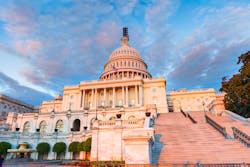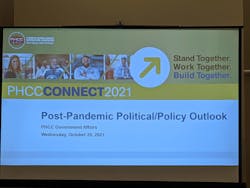KANSAS CITY, MO — On Wednesday, October 20th, Mark Valentini, Director, Legislative Affairs, and Chuck White, VP, Regulatory Affairs, gave a joint presentation at PHCCCONNECT2021, "The PostPandemic Political Policy Outlook That Impacts You," to a sizeable early-morning crowd.
The BIF and the BBB
Valentini lead off with the legislative update. And all the buzz around Washington is concerning the Bipartisan Infrastructure Framework (or BIF). It contains $579 billion in new spending. For a partial breakdown:
- $55 billion marked for water infrastructure
- $47 billion for resiliency
- $5 billion to address the water shortage in the western states
- $73 billion to update the power grid.
- 274 billion towards transportation (which is sure to spur all kinds of development)
While the BIF should have passed back in September, it has been delayed, with its passage being used as leverage to help pass the Build Back Better plan (BBB), a separate piece of legislation that incorporates a number of social policies and programs from education and healthcare to childcare, housing and climate. While the legislation is still being worked out, it may (or may not):
- Reset the estate tax to 2017 levels
- Increase corporate tax rates and taxes on capital gains
- Push electrification
- Increase union labor in the workforce
- Boost apprenticeships
- Offer paid family leave for four weeks
- Increase recording requirements for banks
At the outset the BBB plan was priced at $3.5 trillion, but the latest reports have the price tag somewhere around $2 trillion over the next decade, with much of it to be paid via tax increases on wealthy corporations and individuals.
Right now, two Democratic senators, Joe Manchin (W-VA and Kyrsten Sinema (AZ) are blocking the BBB's passage—given the one-vote majority of the Democrats in the Senate (and with no votes coming from the Republicans) all the Democrats need to agree for the bill to pass.
Even then, there are complications. To pass by a simple majority (as opposed to the usual 2/3rds majority needed to overcome the filibuster which any single senator may initiate) the bill has to go through a process called reconciliation. To do this, it must pass the "Byrd Bath" (a standard named for the late senator from Virginia, Robert Byrd). This means that every single line item needs to be budget-related. Some elements may not pass the Byrd rule according to the senate parliamentarian (who rules on such matters).
2022 Outlook
Valentini, as he was preparing his presentation, looked through his calendar, and saw so many opportunities for economic havok he decided to call it his "Crisis Checklist." Some highlights:
- Sept. - BBB markup
- Sept. 30 - Continuing Resolution passes
- Sept. 30 - Highway funding extended
- Oct. 18 - Debt ceiling extended
- Oct. 31 - Vote on BIF, BBB
- Oct. 31 - Highway funding extension expires
- Dec. 3 - Continuing resolution and debt ceiling expire
- Dec. 31 - Tax extenders expire
And then there are the Wild Cards, which include (but are not limited to) Afghanistan, China, Russia, North Korea, hurricanes, the Supreme Court, the pandemic, disruptions to the supply chain, the January 6th Commission and, of course, the unknown.
Whatever the outcome on these issues and others, 2022 will still arrive.
The coming year will continue to see difficulty hiring. While Federal unemployment insurance during the pandemic may have depressed hiring, it ended not too long ago and people don't seem to be rushing back to work. Additionally, there are a lot more workers who can and who prefer to work from home.
Licensing will be a big issue in the coming year. There is a big push to eliminate professional licensing in a number of states. While it does need to be easier for people to enter the skilled trades, it should not come at the cost of the trades themselves—the resulting decline in the quality of work would be bad for the consumer and the business owner, and could prove a threat to public health and safety.
Natural gas bans are on the horizon in 2022. California is attempting a phase-out as part of the state's decarbonization efforts. Look to see a full-on ban in new construction (of certain sizes, in certain communities). Consumers will definitely feel the pinch, which may result in increased electrical subsidies in response.
Uncertainty surrounding the pandemic will continue, but hopefully the country returns to something like normal. Although... we were hoping the exact same thing this time last year.
2022 will also see midterm elections. Valentini predicted (with a good deal of certainty) that the Republicans would take back the House and Speaker Pelosi would step down. A lot is going to depend on turnout in the midterms; Democrats perform well when turnout is high, and turnout in the midterms is typically low.
Demographics are going to count for a lot in the midterms. It does not look like the Republicans will take back the Senate due to the rise of urban populations in many red states. The key Senate races to watch are in GA, AZ, PA, NC and WI.
Regulatory Update
Chuck White then took the podium to discuss the new administration's approach to regulation. Key principles are reversing Trump-era actions, advocating on behalf of organized labor, doing more to advance clean technology, and increased oversight of business.
The Department of Energy wants higher efficiency products—it is no longer sufficient to offer "features" on new products instead. The DOE wants to establish condensing products as the baseline for water heating appliances. The PHCC opposes this position, due to the expense and difficulty.
Heat pumps are also being heavily promoted by the new administration, often without much consideration for the correct application of the technology or its limitations in certain climates. Heat pumps are also seen as a key part of the big push towards electrification.
As part of that push, it used to be that "fuel switching"—say from natural gas to electricity—was a factor in the DOE's considerations. It does not seem to be that way any more.
Another big issue in regulation is the transition to lower GWP refrigerants as part of the HFC phase-out. Disposable cylinders are going away (as almost all of the smuggling that happened in Europe when they did their phase-out was in disposable cylinders). One important issue is that different regions will be operating under different rules.
As of Jan. 1st 2023, per the DOE rule, contractors in the north may sell existing inventory until stock is depleted provided it was manufactured prior to January 1, 2023. Those in the south and southwest however do not have this ability; in those regions all products installed must meet the new efficiency standard as of the date of installation—the date of manufacture does not matter. Those in the north will be able to buy product regardless of the rating until inventories are gone, those in the south could have stranded inventory that met the old standard but may not, by law, be installed in those regions as of January 1, 2023. Contractors in the south and southwest regions must be aware of this coming change and plan their inventories accordingly.
Back on the plumbing side of the business, the Trump-era showerhead, dishwasher and clothes washer rules are all being revisited as part of a regulatory see-saw that mirrors the political climate.
Both White and Valentini thanked the attendees, and hoped their analysis would be of value to them in the future.
About the Author
Steve Spaulding
Editor-in-Chief - CONTRACTOR
Steve Spaulding is Editor-in-Chief for CONTRACTOR Magazine. He has been with the magazine since 1996, and has contributed to Radiant Living, NATE Magazine, and other Endeavor Media properties.

